Medium Energy Carbon and Nitrogen Ion Beam Induced Modifications in Charge Transport, Structural and Optical Properties of Ni/Pd/n-GaN Schottky Barrier Diodes
Abstract
:1. Introduction
2. Materials and Methods
3. Results
3.1. SRIM and TRIM Simulations
3.2. Current-Voltage (I-V) Characteristics
3.3. Capacitance-Voltage (C-V) Characteristics
3.4. Photoluminescence (PL)
3.5. X-Ray Diffraction (XRD)
4. Discussion
5. Conclusions
Author Contributions
Funding
Acknowledgments
Conflicts of Interest
References
- Kumar, A.; Asokan, K.; Kumar, V.; Singh, R. Temperature dependence of 1/f noise in Ni/n-GaN Schottky barrier diode. J. Appl. Phys. 2012, 112, 024507. [Google Scholar] [CrossRef]
- Rideout, V.L. A review of the theory and technology for ohmic contacts to group III–V compound semiconductors. Solid State Electron. 1975, 18, 541–550. [Google Scholar] [CrossRef]
- Omotoso, E.; Meyer, W.E.; Auret, F.D.; Paradzah, A.T.; Diale, M.; Coelho, S.M.; van Rensburg, P.J. The influence of high energy electron irradiation on the Schottky barrier height and the Richardson constant of Ni/4H-SiC Schottky diodes. Mater. Sci. Semicond. Process. 2015, 39, 112–118. [Google Scholar] [CrossRef] [Green Version]
- Omotoso, E.; Meyer, W.E.; van Rensburg, P.J.; Igumbor, E.; Tunhuma, S.M.; Ngoepe, P.N.M.; Danga, H.T.; Auret, F.D. The effects of high-energy proton irradiation on the electrical characteristics of Au/Ni/4H-SiC Schottky barrier diodes. Nucl. Instrum. Methods Phys. Res. Sect. B Beam Interact. Mater. At. 2017, 409, 241–245. [Google Scholar] [CrossRef]
- Millán, J.; Godignon, P.; Perpiñà, X.; Pérez-Tomás, A.; Rebollo, J. A survey of wide bandgap power semiconductor devices. IEEE Trans. Power Electron. 2013, 29, 2155–2163. [Google Scholar] [CrossRef]
- Zhang, Y.; Debelle, A.; Boulle, A.; Kluth, P.; Tuomisto, F. Advanced techniques for characterization of ion beam modified materials. Curr. Opin. Solid State Mater. Sci. 2015, 19, 19–28. [Google Scholar] [CrossRef] [Green Version]
- Sun, Y.; Kang, X.; Zheng, Y.; Lu, J.; Tian, X.; Wei, K.; Wu, H.; Wang, W.; Liu, X.; Zhang, G. Review of the recent progress on GaN-based vertical power Schottky barrier diodes (SBDs). Electronics 2019, 8, 575. [Google Scholar] [CrossRef] [Green Version]
- Liang, F.; Zhao, D.; Jiang, D.; Liu, Z.; Zhu, J.; Chen, P.; Yang, J.; Liu, S.; Xing, Y.; Zhang, L. Role of Si and C Impurities in Yellow and Blue Luminescence of Unintentionally and Si-Doped GaN. Nanomaterials 2018, 8, 1026. [Google Scholar] [CrossRef] [PubMed] [Green Version]
- Santana, G.; De Melo, O.; Aguilar-Hernández, J.; Mendoza-Pérez, R.; Monroy, B.; Escamilla-Esquivel, A.; López-López, M.; De Moure, F.; Hernández, L.; Contreras-Puente, G. Photoluminescence study of gallium nitride thin films obtained by infrared close space vapor transport. Materials 2013, 6, 1050–1060. [Google Scholar] [CrossRef] [PubMed] [Green Version]
- Lee, M.; Vu, T.; Lee, K.; Kim, E.; Park, S. Electronic Transport Mechanism for Schottky Diodes Formed by Au/HVPE a-Plane GaN Templates Grown via In Situ GaN Nanodot Formation. Nanomaterials 2018, 8, 397. [Google Scholar] [CrossRef] [PubMed] [Green Version]
- Son, K.; Liao, A.; Lung, G.; Gallegos, M.; Hatake, T.; Harris, R.D.; Scheick, L.Z.; Smythe, W.D. GaN-based high temperature and radiation-hard electronics for harsh environments. Nanosci. Nanotechnol. Lett. 2010, 2, 89–95. [Google Scholar] [CrossRef]
- Dalla Vecchia, M.; Ravyts, S.; Van den Broeck, G.; Driesen, J. Gallium-Nitride Semiconductor Technology and Its Practical Design Challenges in Power Electronics Applications: An Overview. Energies 2019, 12, 2663. [Google Scholar] [CrossRef] [Green Version]
- Ahmad, I.; Akram, W. Introductory Chapter: Introduction to Ion Implantation. In Ion Implantation-Research and Application; IntechOpen: London, UK, 2017. [Google Scholar]
- Williams, J.S. Ion implantation of semiconductors. Mater. Sci. Eng. A 1998, 253, 8–15. [Google Scholar] [CrossRef] [Green Version]
- Newell, P.T.; Meng, C.-I. Ion acceleration at the equatorward edge of the cusp: Low altitude observations of patchy merging. Geophys. Res. Lett. 1991, 18, 1829–1832. [Google Scholar] [CrossRef]
- Thomé, L.; Debelle, A.; Garrido, F.; Mylonas, S.; Décamps, B.; Bachelet, C.; Sattonnay, G.; Moll, S.; Pellegrino, S.; Miro, S. Radiation effects in nuclear materials: Role of nuclear and electronic energy losses and their synergy. Nucl. Instrum. Methods Phys. Res. Sect. B Beam Interact. Mater. At. 2013, 307, 43–48. [Google Scholar] [CrossRef]
- Qi, Q.; Cheng, G.J.; Shi, L.Q.; O’Connor, D.J.; King, B.V.; Kisi, E.H. Damage accumulation and recovery in C+-irradiated Ti3SiC2. Acta Mater. 2014, 66, 317–325. [Google Scholar] [CrossRef]
- Knetzger, M.; Meissner, E.; Schröter, C.; Friedrich, J. Theoretical aspects and microstructural investigations on V-pit defects in HVPE grown GaN. J. Cryst. Growth 2019, 518, 51–58. [Google Scholar] [CrossRef]
- Pearton, S.J.; Ren, F.; Patrick, E.; Law, M.E.; Polyakov, A.Y. Ionizing radiation damage effects on GaN devices. Ecs J. Solid State Sci. Technol. 2016, 5, Q35–Q60. [Google Scholar] [CrossRef] [Green Version]
- Pearton, S.J.; Deist, R.; Ren, F.; Liu, L.; Polyakov, A.Y.; Kim, J. Review of radiation damage in GaN-based materials and devices. J. Vac. Sci. Technol. A Vac. Surf. Film. 2013, 31, 050801. [Google Scholar] [CrossRef] [Green Version]
- Kumar, A.; Dhillon, J.; Verma, S.; Kumar, P.; Asokan, K.; Kanjilal, D. Identification of swift heavy ion induced defects in Pt/n-GaN Schottky diodes by in-situ deep level transient spectroscopy. Semicond. Sci. Technol. 2018, 33, 085008. [Google Scholar] [CrossRef]
- Kumar, A.; Singh, R.; Kumar, P.; Singh, U.B.; Asokan, K.; Karaseov, P.A.; Titov, A.I.; Kanjilal, D. In-situ transport and microstructural evolution in GaN Schottky diodes and epilayers exposed to swift heavy ion irradiation. J. Appl. Phys. 2018, 123, 161539. [Google Scholar] [CrossRef]
- Zhang, L.Q.; Zhang, C.H.; Li, J.J.; Meng, Y.C.; Yang, Y.T.; Song, Y.; Ding, Z.N.; Yan, T.X. Damage to epitaxial GaN layer on Al 2 O 3 by 290-MeV 238 U 32+ ions irradiation. Sci. Rep. 2018, 8, 1–10. [Google Scholar]
- Karlušić, M.; Kozubek, R.; Lebius, H.; Ban-d’Etat, B.; Wilhelm, R.A.; Buljan, M.; Siketić, Z.; Scholz, F.; Meisch, T.; Jakšić, M. Response of GaN to energetic ion irradiation: Conditions for ion track formation. J. Phys. D Appl. Phys. 2015, 48, 325304. [Google Scholar] [CrossRef] [Green Version]
- Kucheyev, S.O.; Williams, J.S.; Pearton, S.J. Ion implantation into GaN. Mater. Sci. Eng. R Rep. 2001, 33, 51–108. [Google Scholar] [CrossRef]
- Ding, F.R.; He, W.H.; Vantomme, A.; Zhao, Q.; Pipeleers, B.; Jacobs, K.; Moerman, I. Lattice expansion induced by Zn channeled implantation in GaN. Mater. Sci. Semicond. Process. 2002, 5, 511–514. [Google Scholar] [CrossRef]
- Li, B.S.; Liu, H.P.; Xu, L.J.; Wang, J.; Song, J.; Peng, D.P.; Li, J.H.; Zhao, F.Q.; Kang, L.; Zhang, T.M. Lattice disorder and N elemental segregation in ion implanted GaN epilayer. Appl. Surf. Sci. 2020, 499, 143911. [Google Scholar] [CrossRef]
- Kumar, D.R.; Ranjith, K.S.; Nivedita, L.R.; Asokan, K.; Kumar, R.R. Swift heavy ion induced effects on structural, optical and photo-catalytic properties of Ag irradiated vertically aligned ZnO nanorod arrays. Nucl. Instrum. Methods Phys. Res. Sect. B Beam Interact. Mater. At. 2019, 450, 95–99. [Google Scholar] [CrossRef]
- Duboz, J.-Y.; Zucchi, J.; Frayssinet, E.; Chalbet, P.; Chenot, S.; Hugues, M.; Grini, J.-C.; Vidal, M.; Herault, J. GaN Schottky diodes for proton beam monitoring. Biomed. Phys. Eng. Express 2018, 5, 025015. [Google Scholar] [CrossRef] [Green Version]
- Baskar, K. Shodhganga, MOCVD Growth and Characterization of InGaN and InGaN GaN Quantumwell Structures and Effect of Ion Irradiation. 2018. Available online: http://shodhganga.inflibnet.ac.in:8080/jspui/handle/10603/234176 (accessed on 17 November 2019).
- Titov, A.I.; Karabeshkin, K.V.; Karaseov, P.A.; Struchkov, A.I. Do Chemical Effects Affect the Accumulation of Structural Damage during the Implantation of Fluorine Ions into GaN? Semiconductors 2019, 53, 1415–1418. [Google Scholar] [CrossRef]
- Ngoepe, P.N.M.; Meyer, W.E.; Auret, F.D.; Omotoso, E.; Hlatshwayo, T.T.; Diale, M. Characterisation of Cs ion implanted GaN by DLTS. Phys. B Condens. Matter 2018, 535, 96–98. [Google Scholar] [CrossRef]
- Yoshino, M.; Sugamata, K.; Ikeda, K.; Nishimura, T.; Kuriyama, K.; Nakamura, T. Ion implanted GaN MISFETs fabricated in Mg implanted layers activated by conventional rapid thermal annealing. Nucl. Instrum. Methods Phys. Res. Sect. B Beam Interact. Mater. At. 2019, 449, 49–53. [Google Scholar] [CrossRef]
- Macková, A.; Malinský, P.; Jágerová, A.; Sofer, Z.; Sedmidubský, D.; Klímová, K.; Böttger, R.; Akhmadaliev, S. Damage accumulation and structural modification in a-and c-plane GaN implanted with 400-keV and 5-MeV Au+ ions. Surf. Interface Anal. 2018, 50, 1099–1105. [Google Scholar] [CrossRef]
- Lei, Z.F.; Guo, H.X.; Tang, M.H.; Zeng, C.; Zhang, Z.G.; Chen, H.; En, Y.F.; Huang, Y.; Chen, Y.Q.; Peng, C. Degradation mechanisms of AlGaN/GaN HEMTs under 800 MeV Bi ions irradiation. Microelectron. Reliab. 2018, 80, 312–316. [Google Scholar] [CrossRef]
- Reddy, M.S.P.; Kumar, A.A.; Reddy, V.R. Electrical transport characteristics of Ni/Pd/n-GaN Schottky barrier diodes as a function of temperature. Thin Solid Film. 2011, 519, 3844–3850. [Google Scholar] [CrossRef]
- Plante, J. Alternative Test Methods for Electronic Parts. NEPP, 2004. Available online: https://www.google.com/search?sxsrf=ACYBGNTB1bBEh47D_ZH76g5LO77HX6s4ug%3A1582113514934&ei=6iJNXtPLOMXIyAPmv4O4AQ&q=Plante%2C+J.++Alternative+test+methods+for+electronic+parts.+2004.&oq=Plante%2C+J.++Alternative+test+methods+for+electronic+parts.+2004.&gs_l=psy-ab.3...2391.2989..3747...0.2..1.354.998.0j1j2j1......0....1..gws-wiz.......0i71.BhWDBlfkRXU&ved=0ahUKEwjT6LSQyN3nAhVFJHIKHebfABcQ4dUDCAs&uact=5 (accessed on 10 November 2019).
- Stoller, R.E.; Toloczko, M.B.; Was, G.S.; Certain, A.G.; Dwaraknath, S.; Garner, F.A. On the use of SRIM for computing radiation damage exposure. Nucl. Instrum. Methods Phys. Res. Sect. B Beam Interact. Mater. At. 2013, 310, 75–80. [Google Scholar] [CrossRef]
- Kumar, M.V.; Verma, S.; Shobha, V.; Jayashree, B.; Kanjilal, D.; Krishnaveni, S. 100 MeV Si^ sup 7+^ Ion Irradiation Induced Modifications in Electrical Characteristics of Si Photo Detector: An In-Situ Reliability Study. J. Mater. Sci. Res. 2014, 3, 24. [Google Scholar]
- Kumar, M.V.; Verma, S.; Asokan, K.; Shobha, V.; Karanth, S.P.; Krishnaveni, S. In Situ Electrical Characteristics of 150 MeV Ag9+ Ion Beam Induced Damage in Si Photo Detector. ECS J. Solid State Sci. Technol. 2016, 5, P384–P388. [Google Scholar] [CrossRef]
- Herring, C.; Nichols, M.H. Thermionic emission. Rev. Mod. Phys. 1949, 21, 185. [Google Scholar] [CrossRef]
- Norde, H. A modified forward I-V plot for Schottky diodes with high series resistance. J. Appl. Phys. 1979, 50, 5052–5053. [Google Scholar] [CrossRef]
- Lien, C.-D.; So, F.C.T.; Nicolet, M.-A. An improved forward IV method for nonideal Schottky diodes with high series resistance. IEEE Trans. Electron Devices 1984, 31, 1502–1503. [Google Scholar] [CrossRef] [Green Version]
- Goodman, S.A.; Auret, F.D.; Meyer, W.E. The effect of alpha-particle and proton irradiation on the electrical and defect properties of n-GaAs. Nucl. Instrum. Methods Phys. Res. Sect. B Beam Interact. Mater. At. 1994, 90, 349–353. [Google Scholar] [CrossRef]
- Karmarkar, A.P.; Jun, B.; Fleetwood, D.M.; Schrimpf, R.D.; Weller, R.A.; White, B.D.; Brillson, L.J.; Mishra, U.K. Proton irradiation effects on GaN-based high electron-mobility transistors with Si-doped Al/sub x/Ga/sub 1-x/N and thick GaN cap Layers. IEEE Trans. Nucl. Sci. 2004, 51, 3801–3806. [Google Scholar] [CrossRef]
- Mazey, D.J.; Nelson, R.S.; Barnes, R.S. Observation of ion bombardment damage in silicon. Philos. Mag. 1968, 17, 1145–1161. [Google Scholar] [CrossRef]
- Sadoun, A.; Mansouri, S.; Chellali, M.; Lakhdar, N.; Hima, A.; Benamara, Z. Investigation, analysis and comparison of current-voltage characteristics for Au/Ni/GaN Schottky structure using IVT simulation. Mater. Sci. Pol. 2019, 1. [Google Scholar] [CrossRef] [Green Version]
- Arslan, E.; Altındal, Ş.; Ural, S.; Kayal, Ö.A.; Öztürk, M.; Özbay, E. Thermal Annealing Effects on the Electrical and Structural Properties of Ni/Pt Schottky Contacts on the Quaternary AlInGaN Epilayer. J. Electron. Mater. 2019, 48, 887–897. [Google Scholar] [CrossRef] [Green Version]
- Fretwurst, E.; Lindstrom, G.; Pintilie, I.; Stahl, J. Radiation damage in silicon detectors caused by hadronic and electromagnetic irradiation. arXiv 2002, arXiv:physics/0211118. [Google Scholar]
- Kumar, S.; Katharria, Y.S.; Batra, Y.; Kanjilal, D. Influence of swift heavy ion irradiation on electrical characteristics of Au/n-Si (1 0 0) Schottky barrier structure. J. Phys. D Appl. Phys. 2007, 40, 6892. [Google Scholar] [CrossRef]
- Manikanthababu, N.; Vajandar, S.; Arun, N.; Pathak, A.P.; Asokan, K.; Osipowicz, T.; Basu, T.; Nageswara Rao, S.V.S. Electronic excitation induced defect dynamics in HfO2 based MOS devices investigated by in-situ electrical measurements. Appl. Phys. Lett. 2018, 112, 131601. [Google Scholar] [CrossRef]
- Spradlin, J.; Doǧan, S.; Xie, J.; Molnar, R.; Baski, A.A.; Morkoç, H. Investigation of forward and reverse current conduction in GaN films by conductive atomic force microscopy. Appl. Phys. Lett. 2004, 84, 4150–4152. [Google Scholar] [CrossRef]
- Aydoğan, Ş.; İncekara, Ü.; Deniz, A.R.; Türüt, A. Extraction of electronic parameters of Schottky diode based on an organic Orcein. Microelectron. Eng. 2010, 87, 2525–2530. [Google Scholar] [CrossRef]
- Ocak, Y.S.; Kulakci, M.; Kılıçoğlu, T.; Turan, R.; Akkılıç, K. Current–voltage and capacitance–voltage characteristics of a Sn/Methylene Blue/p-Si Schottky diode. Synth. Met. 2009, 159, 1603–1607. [Google Scholar] [CrossRef]
- Reddy, V.R.; Janardhanam, V.; Ju, J.-W.; Yun, H.-J.; Choi, C.-J. Electronic parameters and carrier transport mechanism of high-barrier Se Schottky contacts to n-type GaN. Solid State Commun. 2014, 179, 34–38. [Google Scholar] [CrossRef]
- Silpa, D.S.; Sreehith, P.; Reddy, V.R.; Janardhanam, V. Transport mechanisms and interface properties of W/p-InP Schottky diode at room temperature. Indian J. Phys. 2016, 90, 399–406. [Google Scholar] [CrossRef]
- Kim, Y.; Ohmi, S.-I.; Tsutsui, K.; Iwai, H. Electrical Properties of Condensed Matter-Space-Charge-Limited Currents in La2O3 Thin Films Deposited by E-Beam Evaporation after Low Temperature Dry-Nitrogen Annealing. Jpn. J. Appl. Phys. Part 1 Regul. Pap. Short Notes 2005, 44, 4032–4042. [Google Scholar] [CrossRef]
- Güllü, Ö.; Aydoğan, Ş.; Türüt, A. Fabrication and electrical characteristics of Schottky diode based on organic material. Microelectron. Eng. 2008, 85, 1647–1651. [Google Scholar] [CrossRef]
- Riad, A.S. Influence of dioxygen and annealing process on the transport properties of nickel phthalocyanine Schottky-barrier devices. Phys. B Condens. Matter 1999, 270, 148–156. [Google Scholar] [CrossRef]
- Janardhanam, V.; Lee, H.-K.; Shim, K.-H.; Hong, H.-B.; Lee, S.-H.; Ahn, K.-S.; Choi, C.-J. Temperature dependency and carrier transport mechanisms of Ti/p-type InP Schottky rectifiers. J. Alloys Compd. 2010, 504, 146–150. [Google Scholar] [CrossRef]
- Hacke, P.; Detchprohm, T.; Hiramatsu, K.; Sawaki, N. Schottky barrier on n-type GaN grown by hydride vapor phase epitaxy. Appl. Phys. Lett. 1993, 63, 2676–2678. [Google Scholar] [CrossRef]
- Sze, S.M. Semiconductor Devices: Physics and Technology; John Wiley & Sons: Hoboken, NJ, USA, 2008. [Google Scholar]
- Armitage, R.; Yang, Q.; Weber, E.R. Analysis of the carbon-related “blue” luminescence in GaN. J. Appl. Phys. 2005, 97, 073524. [Google Scholar] [CrossRef] [Green Version]
- Ionascut-Nedelcescu, A.; Carlone, C.; Houdayer, A.; Von Bardeleben, H.J.; Cantin, J.L.; Raymond, S. Radiation Hardness in Gallium Nitride. IEEE Trans. Nucl. Sci. 2002, 49, 2733–2738. [Google Scholar] [CrossRef]
- Thaik, M.; Hömmerich, U.; Schwartz, R.N.; Wilson, R.G.; Zavada, J.M. Photoluminescence spectroscopy of erbium implanted gallium nitride. Appl. Phys. Lett. 1997, 71, 2641–2643. [Google Scholar] [CrossRef]
- Mettler, K. Photoluminescence as a tool for the study of the electronic surface properties of gallium arsenide. Appl. Phys. 1977, 12, 75–82. [Google Scholar] [CrossRef]
- Reshchikov, M.A.; Morkoç, H. Luminescence properties of defects in GaN. J. Appl. Phys. 2005, 97, 5–19. [Google Scholar] [CrossRef]
- Liang, F.; Zhao, D.; Jiang, D.; Liu, Z.; Zhu, J.; Chen, P.; Yang, J.; Liu, S.; Xing, Y.; Zhang, L. Carbon-related defects as a source for the enhancement of yellow luminescence of unintentionally doped GaN. Nanomaterials 2018, 8, 744. [Google Scholar] [CrossRef] [PubMed] [Green Version]
- Ren, B.; Liao, M.; Sumiya, M.; Wang, L.; Koide, Y.; Sang, L. Nearly ideal vertical GaN Schottky barrier diodes with ultralow turn-on voltage and on-resistance. Appl. Phys. Express 2017, 10, 051001. [Google Scholar] [CrossRef]
- Okumura, H.; Ohta, K.; Feuillet, G.; Balakrishnan, K.; Chichibu, S.; Hamaguchi, H.; Hacke, P.; Yoshida, S. Growth and characterization of cubic GaN. J. Cryst. Growth 1997, 178, 113–133. [Google Scholar] [CrossRef]
- Wong, W.S.; Sands, T.; Cheung, N.W. Damage-free separation of GaN thin films from sapphire substrates. Appl. Phys. Lett. 1998, 72, 599–601. [Google Scholar] [CrossRef]
- Nasr, F.B.; Guermazi, H.; Guermazi, S. Correlation between structural and optical properties of GaN epi-layers by the cathodoluminescence technique. Eur. Phys. J. Plus 2016, 131, 195. [Google Scholar] [CrossRef]
- Pong, B.J.; Pan, C.J.; Teng, Y.C.; Chi, G.C.; Li, W.-H.; Lee, K.C.; Lee, C.-H. Structural defects and microstrain in GaN induced by Mg ion implantation. J. Appl. Phys. 1998, 83, 5992–5996. [Google Scholar] [CrossRef]
- Qadri, S.B.; Molnar, B.; Yousuf, M.; Carosella, C.A. X-ray determination of strain in ion implanted GaN. Nucl. Instrum. Methods Phys. Res. Sect. B Beam Interact. Mater. At. 2002, 190, 878–881. [Google Scholar] [CrossRef]
- Robertson, J. Amorphous carbon. Adv. Phys. 1986, 35, 317–374. [Google Scholar] [CrossRef]
- Tzou, A.-J.; Hsieh, D.-H.; Chen, S.-H.; Liao, Y.-K.; Li, Z.-Y.; Chang, C.-Y.; Kuo, H.-C. An investigation of carbon-doping-induced current collapse in GaN-on-Si high electron mobility transistors. Electronics 2016, 5, 28. [Google Scholar] [CrossRef] [Green Version]
- Kucheyev, S.O.; Williams, J.S.; Jagadish, C.; Zou, J.; Li, G. Damage buildup in GaN under ion bombardment. Phys. Rev. B 2000, 62, 7510. [Google Scholar] [CrossRef] [Green Version]
- Kucheyev, S.O.; Bradby, J.E.; Li, C.P.; Ruffell, S.; van Buuren, T.; Felter, T.E. Effects of carbon on ion-implantation-induced disorder in GaN. Appl. Phys. Lett. 2007, 91, 261905. [Google Scholar] [CrossRef] [Green Version]
- Nordlund, K. Atomistic simulation of radiation effects in carbon-based materials and nitrides. Nucl. Instrum. Methods Phys. Res. Sect. B Beam Interact. Mater. At. 2004, 218, 9–18. [Google Scholar] [CrossRef]
- Kucheyev, S.O.; Williams, J.S.; Jagadish, C.; Zou, J.; Li, G.; Titov, A.I. Effect of ion species on the accumulation of ion-beam damage in GaN. Phys. Rev. B 2001, 64, 035202. [Google Scholar] [CrossRef] [Green Version]
- Manasreh, M.O. III-Nitride Semiconductors: Electrical, Structural and Defects Properties; Elsevier: Amsterdam, The Netherlands, 2000. [Google Scholar]
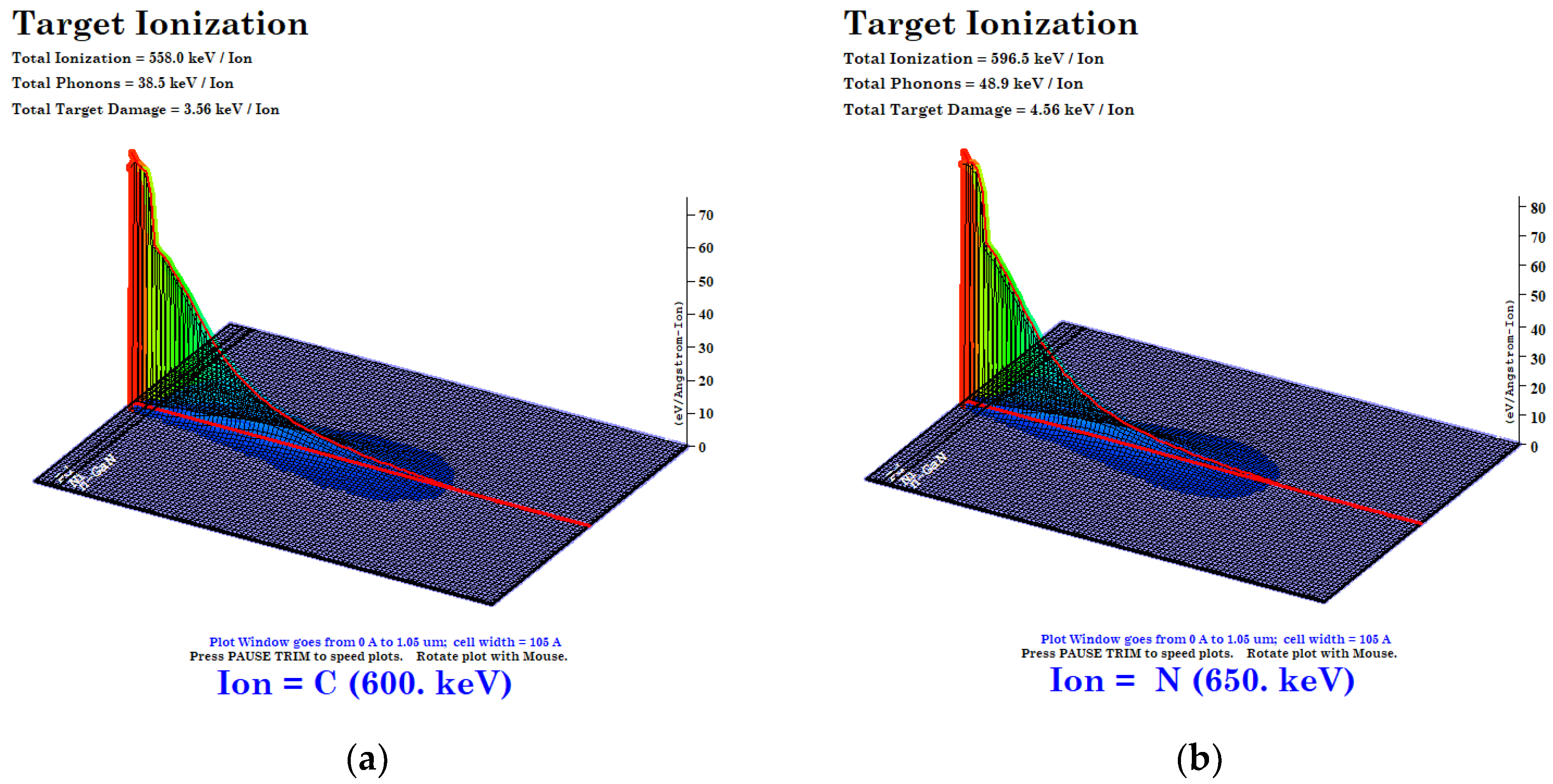
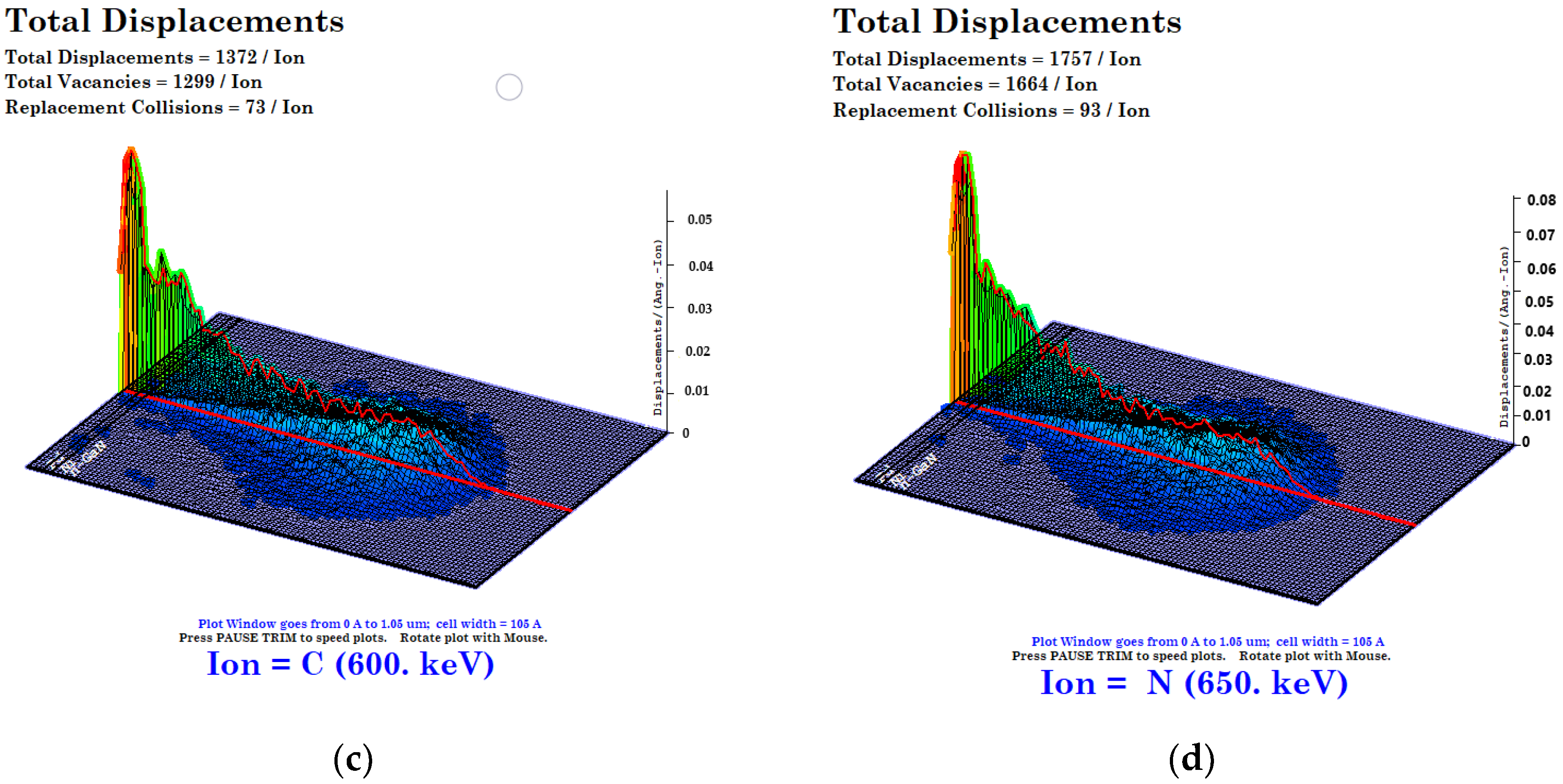
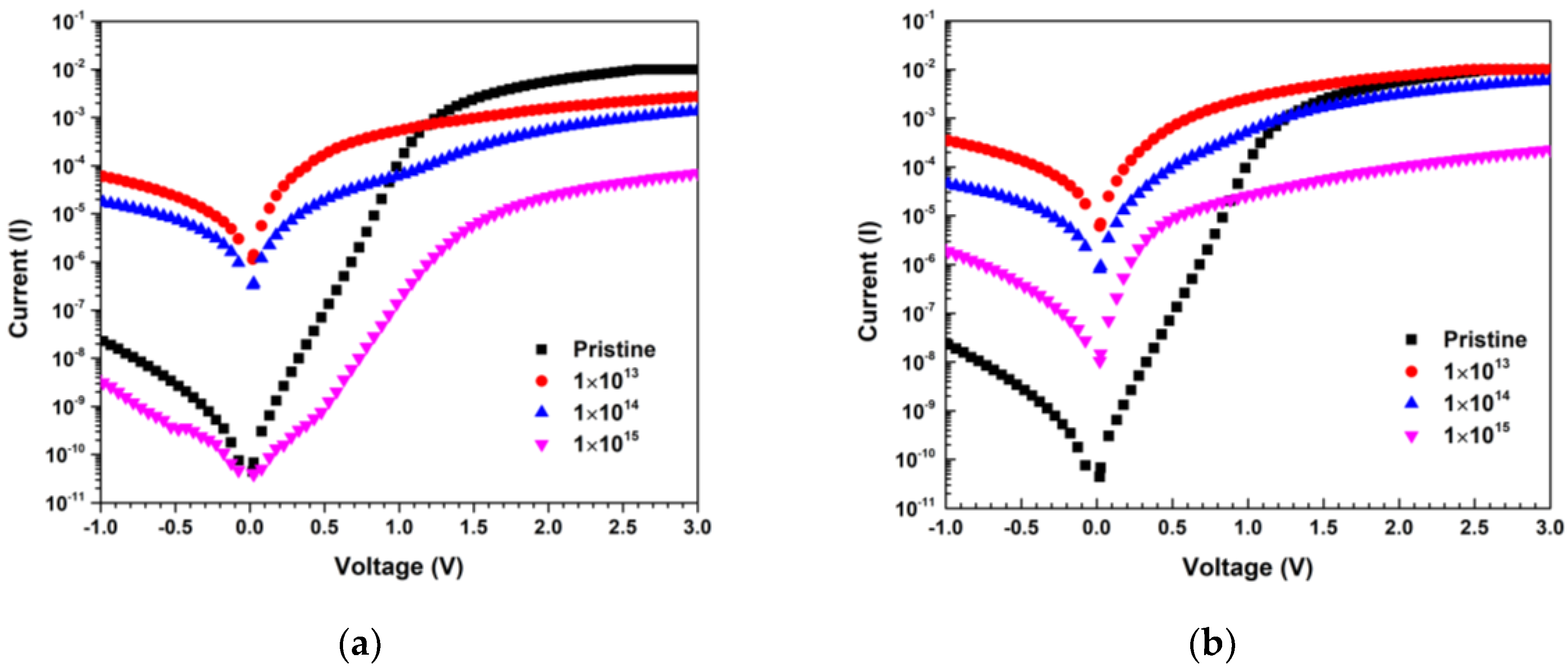
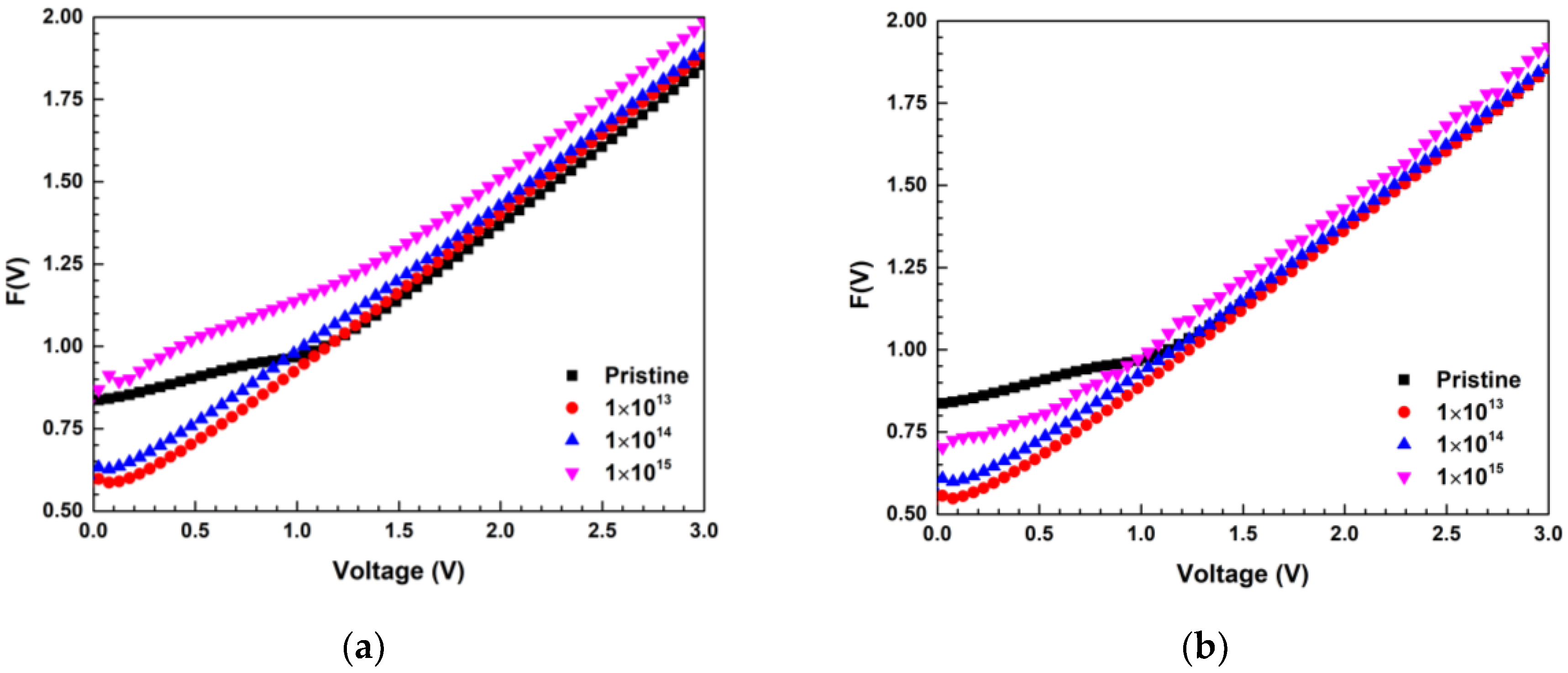

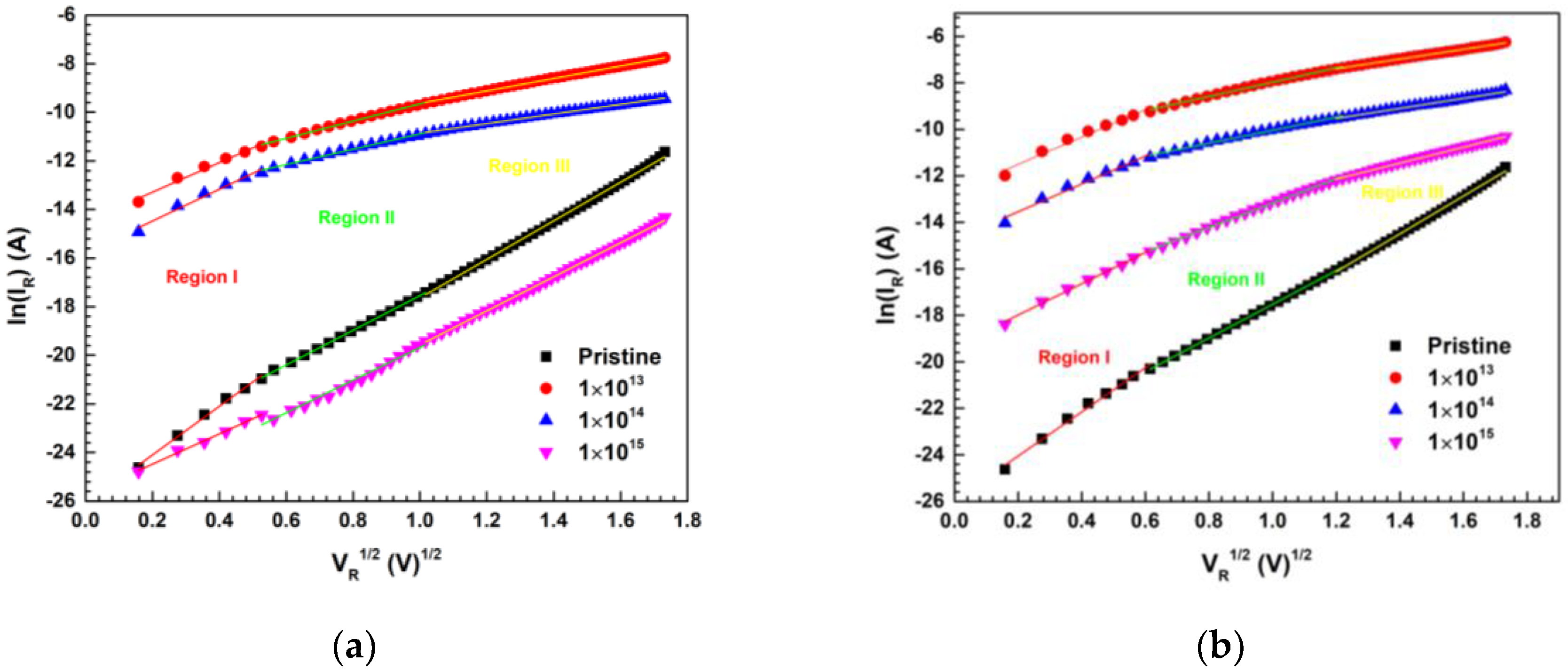

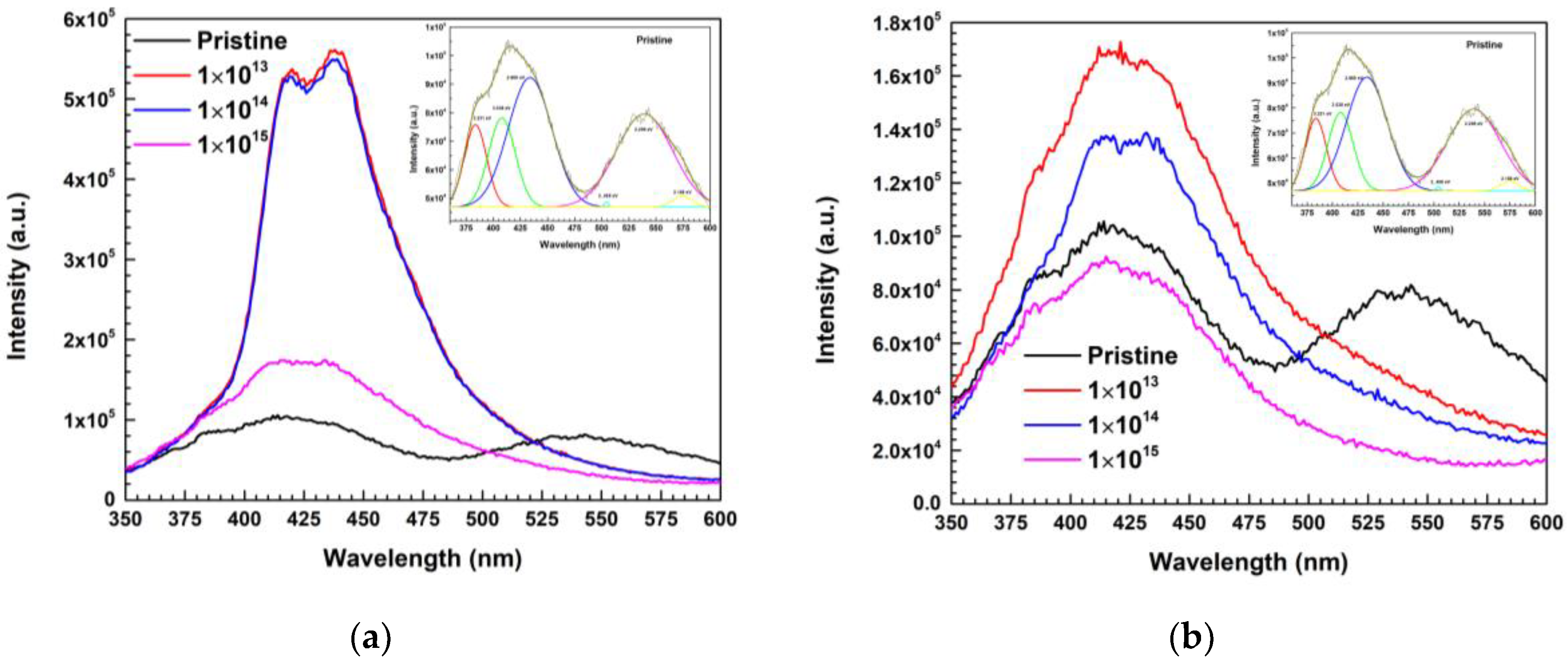
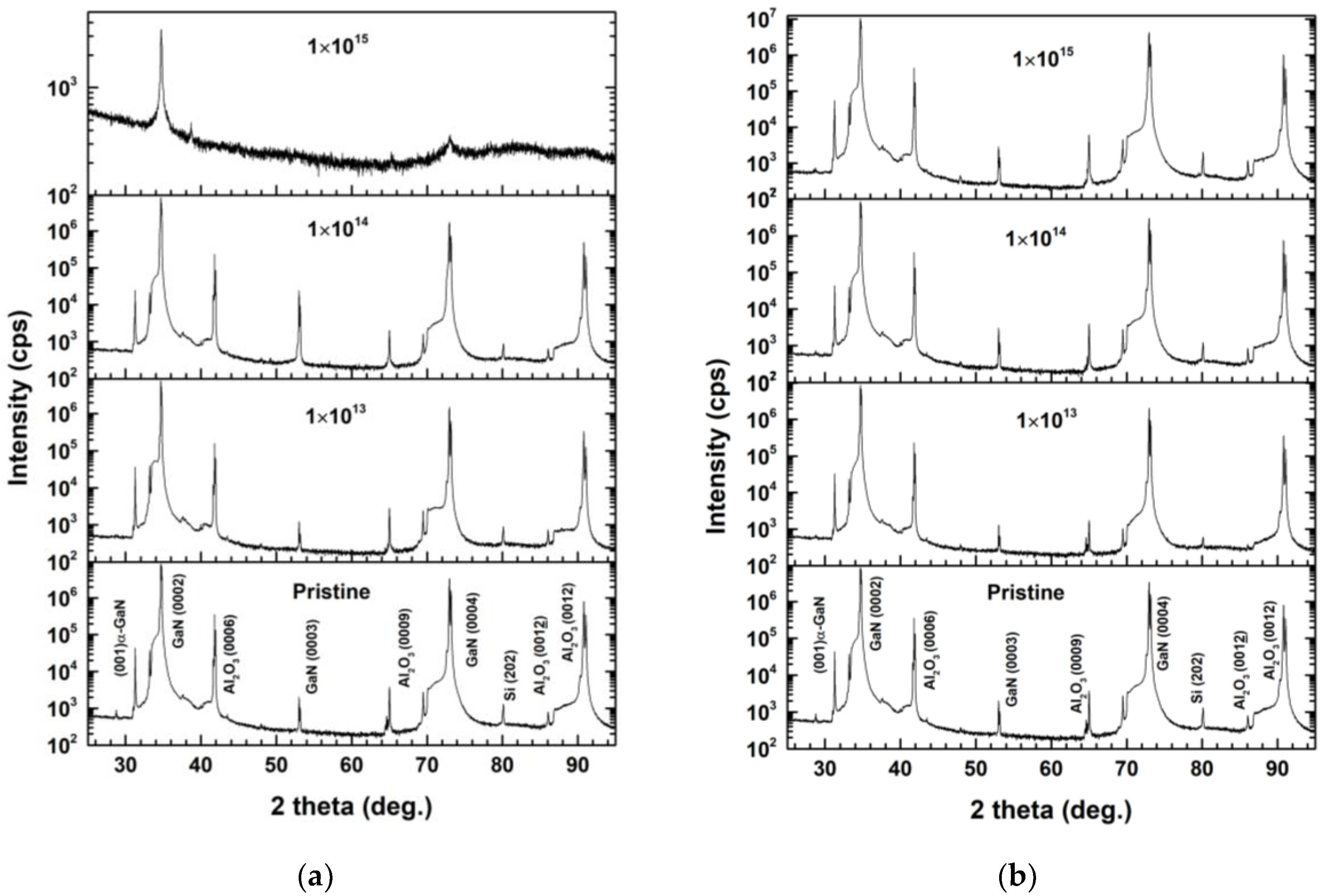
| Ion | Range, R (A0) | Displacement/Ion | Vacancies/Ion | Replacement Collisions/Ion | NIEL (MeV cm2/g) | LET (MeV cm2/g) | Sn/Se |
|---|---|---|---|---|---|---|---|
| Carbon | 6663 | 1372 | 1299 | 73 | 1.57 × 102 | 1.47 × 103 | 3.1 × 10−2 |
| Nitrogen | 6461 | 1757 | 1664 | 93 | 2.08 × 102 | 1.90 × 103 | 3.2 × 10−2 |
| Fluence (Ions cm−2) | Carbon Ion | Nitrogen Ion | ||
|---|---|---|---|---|
| TID (Rad) | Dd (Rad) | TID (Rad) | Dd (Rad) | |
| 1 × 1013 | 2.36 × 108 | 2.52 × 107 | 3.03 × 108 | 3.33 × 107 |
| 1 × 1014 | 2.36 × 109 | 2.52 × 108 | 3.03 × 109 | 3.33 × 108 |
| 1 × 1015 | 2.36 × 1010 | 2.52 × 109 | 3.03 × 1010 | 3.33 × 109 |
| Ion | Fluence (Ions cm−2) | Ideality Factor (n) | Barrier Height (φB) (eV) | Series Resistance (RS) (Ω) | Saturation Current (I0) (A) | Reverse Leakage Current at −1 V (A) | |
|---|---|---|---|---|---|---|---|
| ln I vs. V | F(V) vs. V | ||||||
| Pristine | 2.37 | 0.844 | 0.824 | 1.91 × 108 | 6.41 × 10−11 | 2.73 × 10−8 | |
| Carbon | 1 × 1013 | 2.76 | 0.582 | 0.598 | 4.56 × 103 | 1.59 × 10−6 | 6.53 × 10−5 |
| 1 × 1014 | 3.41 | 0.618 | 0.639 | 7.14 × 104 | 3.85 × 10−7 | 1.87 × 10−5 | |
| 1 × 1015 | 4.34 | 0.860 | 0.856 | 6.68 × 108 | 3.42 × 10−11 | 3.69 × 10−9 | |
| Nitrogen | 1 × 1013 | 3.35 | 0.538 | 0.560 | 1.03 × 103 | 3.85 × 10−6 | 3.75 × 10−4 |
| 1 × 1014 | 3.29 | 0.591 | 0.611 | 7.49 × 103 | 1.12 × 10−6 | 4.69 × 10−5 | |
| 1 × 1015 | 2.19 | 0.702 | 0.689 | 1.75 × 106 | 3.85 × 10−7 | 2.15 × 10−6 | |
| Fluence (Ions cm−2) | Slope Values | ||||
|---|---|---|---|---|---|
| Ion | Region I | Region II | Region III | Region IV | |
| Pristine | 1.48 | 4.19 | 10.76 | 2.18 | |
| Carbon | 1 × 1013 | 1.36 | 1.89 | 1.59 | 1.50 |
| 1 × 1014 | 1.09 | 1.62 | 2.23 | 2.56 | |
| 1 × 1015 | 0.90 | 1.98 | 8.84 | 3.15 | |
| Nitrogen | 1 × 1013 | 1.27 | 1.86 | 1.85 | 1.19 |
| 1 × 1014 | 1.15 | 1.89 | 2.57 | 1.91 | |
| 1 × 1015 | 1.54 | 2.98 | 6.65 | 2.03 | |
| Ion | Fluence (Ions cm−2) | Experimental Values (10−5 eVm1/2 V −1/2) | |||||
|---|---|---|---|---|---|---|---|
| Region I | Region II | Region III | |||||
| βPF | βSE | βPF | βSE | βPF | βSE | ||
| Pristine | 5.78 | 2.89 | 4.12 | 2.06 | 4.58 | 2.29 | |
| Carbon | 1 × 1013 | 3.51 | 1.75 | 2.05 | 1.02 | 1.47 | 0.739 |
| 1 × 1014 | 3.78 | 1.82 | 0.91 | 0.765 | 1.14 | 0.569 | |
| 1 × 1015 | 3.59 | 1.79 | 3.88 | 1.94 | 4.05 | 2.02 | |
| Nitrogen | 1 × 1013 | 3.39 | 1.70 | 1.60 | 0.886 | 1.21 | 0.601 |
| 1 × 1014 | 3.46 | 1.73 | 1.66 | 0.806 | 1.25 | 0.624 | |
| 1 × 1015 | 3.89 | 1.94 | 3.03 | 1.52 | 1.98 | 0.991 | |
| Ion | Fluence (Ions cm−2) | φB (eV) | Nd (cm−3) |
|---|---|---|---|
| Pristine | 1.146 | 3.38 × 1017 | |
| Carbon | 1 × 1013 | 0.728 | 5.74 × 1017 |
| 1 × 1014 | 0.799 | 3.45 × 1017 | |
| 1 × 1015 | 1.195 | 3.34 × 1017 | |
| Nitrogen | 1 × 1013 | 0.677 | 5.58 × 1017 |
| 1 × 1014 | 0.757 | 3.40 × 1017 | |
| 1 × 1015 | 1.063 | 3.29 × 1017 | |
© 2020 by the authors. Licensee MDPI, Basel, Switzerland. This article is an open access article distributed under the terms and conditions of the Creative Commons Attribution (CC BY) license (http://creativecommons.org/licenses/by/4.0/).
Share and Cite
Kumar, S.; Zhang, X.; Mariswamy, V.K.; Reddy, V.R.; Kandasami, A.; Nimmala, A.; Rao, S.V.S.N.; Tang, J.; Ramakrishnna, S.; Sannathammegowda, K. Medium Energy Carbon and Nitrogen Ion Beam Induced Modifications in Charge Transport, Structural and Optical Properties of Ni/Pd/n-GaN Schottky Barrier Diodes. Materials 2020, 13, 1299. https://doi.org/10.3390/ma13061299
Kumar S, Zhang X, Mariswamy VK, Reddy VR, Kandasami A, Nimmala A, Rao SVSN, Tang J, Ramakrishnna S, Sannathammegowda K. Medium Energy Carbon and Nitrogen Ion Beam Induced Modifications in Charge Transport, Structural and Optical Properties of Ni/Pd/n-GaN Schottky Barrier Diodes. Materials. 2020; 13(6):1299. https://doi.org/10.3390/ma13061299
Chicago/Turabian StyleKumar, Santosh, Xiang Zhang, Vinay Kumar Mariswamy, Varra Rajagopal Reddy, Asokan Kandasami, Arun Nimmala, S V S Nageswara Rao, Jue Tang, Seeram Ramakrishnna, and Krishnaveni Sannathammegowda. 2020. "Medium Energy Carbon and Nitrogen Ion Beam Induced Modifications in Charge Transport, Structural and Optical Properties of Ni/Pd/n-GaN Schottky Barrier Diodes" Materials 13, no. 6: 1299. https://doi.org/10.3390/ma13061299
APA StyleKumar, S., Zhang, X., Mariswamy, V. K., Reddy, V. R., Kandasami, A., Nimmala, A., Rao, S. V. S. N., Tang, J., Ramakrishnna, S., & Sannathammegowda, K. (2020). Medium Energy Carbon and Nitrogen Ion Beam Induced Modifications in Charge Transport, Structural and Optical Properties of Ni/Pd/n-GaN Schottky Barrier Diodes. Materials, 13(6), 1299. https://doi.org/10.3390/ma13061299






